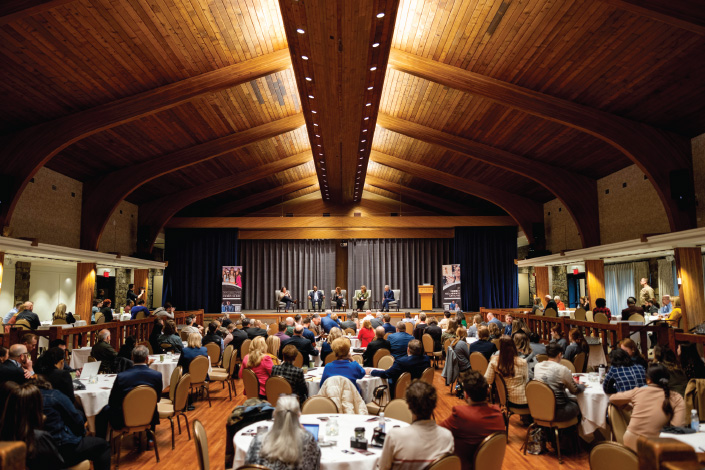By Amber Ravenscroft

Ecosystem building has emerged as a leading strategy for economic development and community revitalization. With the launch of the West Virginia Entrepreneurship Ecosystem (WVEE), the state is at the forefront of this growing movement. What began in 2018 as a coalition of the willing has developed
into a flourishing ecosystem of stakeholders. This network deploys three strategic activities to connect, co-create and educate on the importance of entrepreneurship-led economic development as a growth strategy for West Virginia.
Connect: Ecosystem Building
The broadest, most general definition of an ecosystem is, “a complex network or interconnected system.” In recent years, ecosystem building has emerged as a novel profession at the intersection of community and economic development. Ecosystem builders help connect the fragmented, siloed parts of a local ecosystem to support the core of every entrepreneurship ecosystem—the entrepreneurs. The Appalachian Regional Commission (ARC), a federal agency at the forefront of investment in ecosystem building and a visionary funder of the WVEE alongside the Claude Worthington Benedum Foundation, identified seven essential building blocks of an ecosystem. These include specialized infrastructure, talent, market access, community culture, regulatory/government support, business assistance and capital. Using these as the foundation, West Virginia connects key stakeholders through monthly calls and an annual convening called Bridging Innovation Week. This emphasis on connection helps educate individuals statewide on available opportunities and identify gaps for future co-creation.
“When we started, there were a handful of people at the table. Several institutions were putting a lot of energy into development and duplicating services and events,” says Bill Woodrum, co-founder of the WVEE. “We realized quickly a need to coordinate efforts and to facilitate a mindset that we can do better by working together.”
Co-Create: Catalyzing Collaboration
Entrepreneurship-led economic development relies heavily on co-creation. By mapping the core building blocks and educating broadly on the purpose of ecosystem building, the WVEE supports collective action in addressing key barriers for entrepreneurs through co-created solutions. As the catalyst for this collaboration, the WVEE helps aggregate information and synergize those involved in building solutions to avoid duplication of efforts. What started as the simple sharing of a digital calendar has evolved into the establishment of WV BusinessLink, the state’s go-to platform for entrepreneurs and entrepreneurial support organizations. Bridging Innovation Week engages thousands annually. The WVEE is also launching targeted subcommittee efforts related to the core building blocks of capital, talent and regulatory or government support, cited as the areas of most need within the state. These subcommittees will engage key stakeholders within those building blocks to map existing resources, identify needs and co-create pilot efforts to overcome barriers.
“We have experienced exponential growth. People were craving not just connection, but collaboration,” says Tara St. Clair, co-founder of the WVEE and current co-chair. “There were several events already occurring, so we decided to bring those folks together to bridge the gap and bring key stakeholders together for live networking and collaboration. We had over 1,000 people attend our first week-long Bridging Innovation, and it continues to grow annually.”
James Rumsey Technical Institute’s Company Lab is a powerful example of local impact made possible through co-creation. The Company Lab is a community- and student-facing entrepreneur center housed within a three-county career and technical education site. Recognizing that many aspiring entrepreneurs can be intimidated by traditional business assistance, the Company Lab emphasizes education and personalized learning for entrepreneurs as an entry point to business ownership. In its first 18 months of operation, the Company Lab has served over 40 clients, licensed 12 new businesses, created 15 new jobs and saved clients over $200,000 in revenue and other business expenses.
Educate: Creating a Pipeline
Cultivating a competitive, entrepreneurially minded workforce is a top priority of the WVEE. This includes an emphasis on training the current workforce to meet immediate demand and educating the future workforce on entrepreneurship as a viable career pathway. This focus is already gaining traction in the space of youth entrepreneurship. Bridging Innovation Week features a Youth Entrepreneurship Day, engaging hundreds of students and teachers from across the state in entrepreneurship activities.
Several ecosystem partners, including The EdVenture Group, Marshall University, West Virginia Department of Education and West Virginia University (WVU) have worked collaboratively to launch the state’s first formal entrepreneurship pathway, housed within career and technical education. Through a recent strategic planning effort funded by ARC, WVU Extension published the Equity in Youth Entrepreneurship report. Within this report, the voices of students, teachers and resource providers were captured to identify barriers and set strategic priorities to advance youth entrepreneurship across the state. The results established the Youth Equity in Entrepreneurship subcommittee of the WVEE, which will activate a network of public and private sector partners to advocate for policy change, foster collaboration and provide education and support to providers. Across the K-16 continuum, education leaders and classroom educators are continuing to prioritize entrepreneurship education as a vital contributor to the talent pipeline and larger state entrepreneurship ecosystem.
In education, there is a learning model called the gradual release of responsibility. Within this model, the educator demonstrates a concept, empowers the student by applying the concept in tandem with them and then releases the student to perform the exercise independently. Ecosystem building can be viewed from this lens. Through the WVEE’s work and strategic engagement, West Virginia is building a thriving entrepreneurial ecosystem focused on connecting, co-creating and educating its current citizens and a future generation of entrepreneurs.








